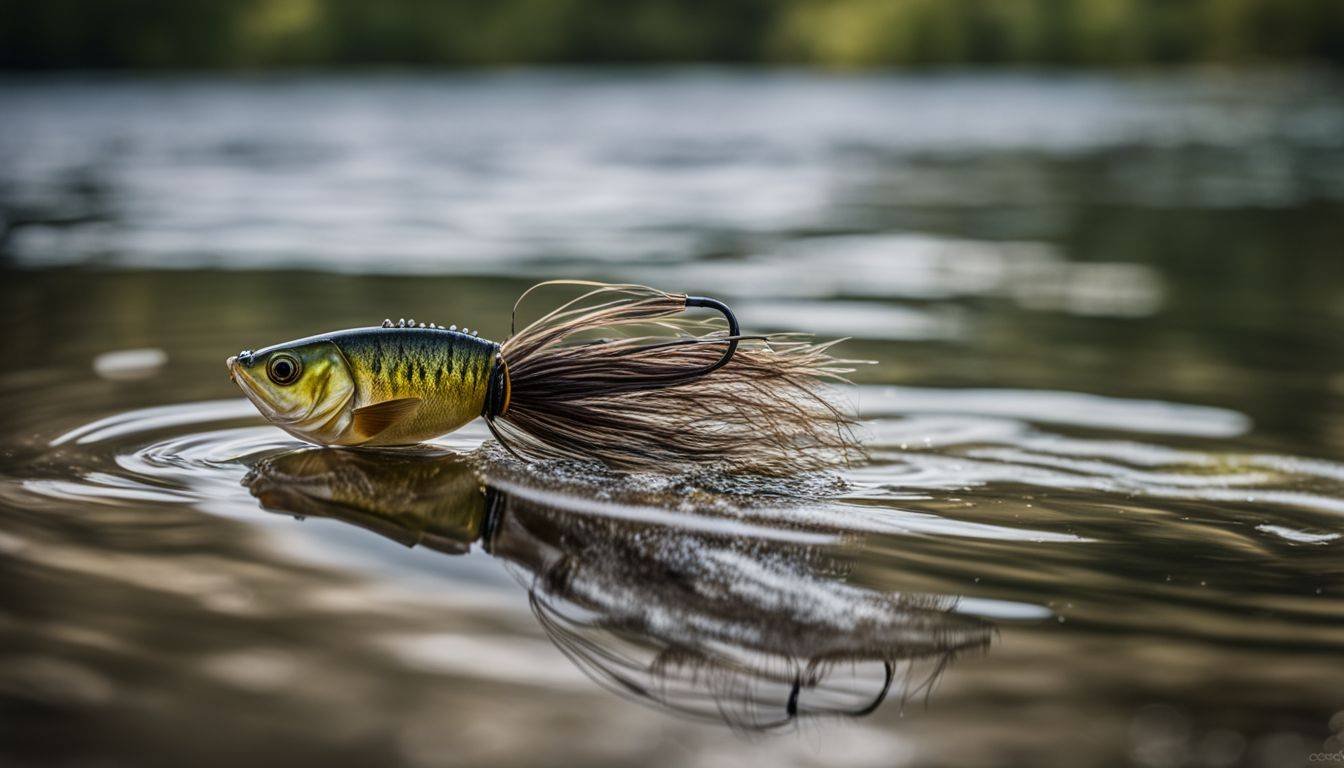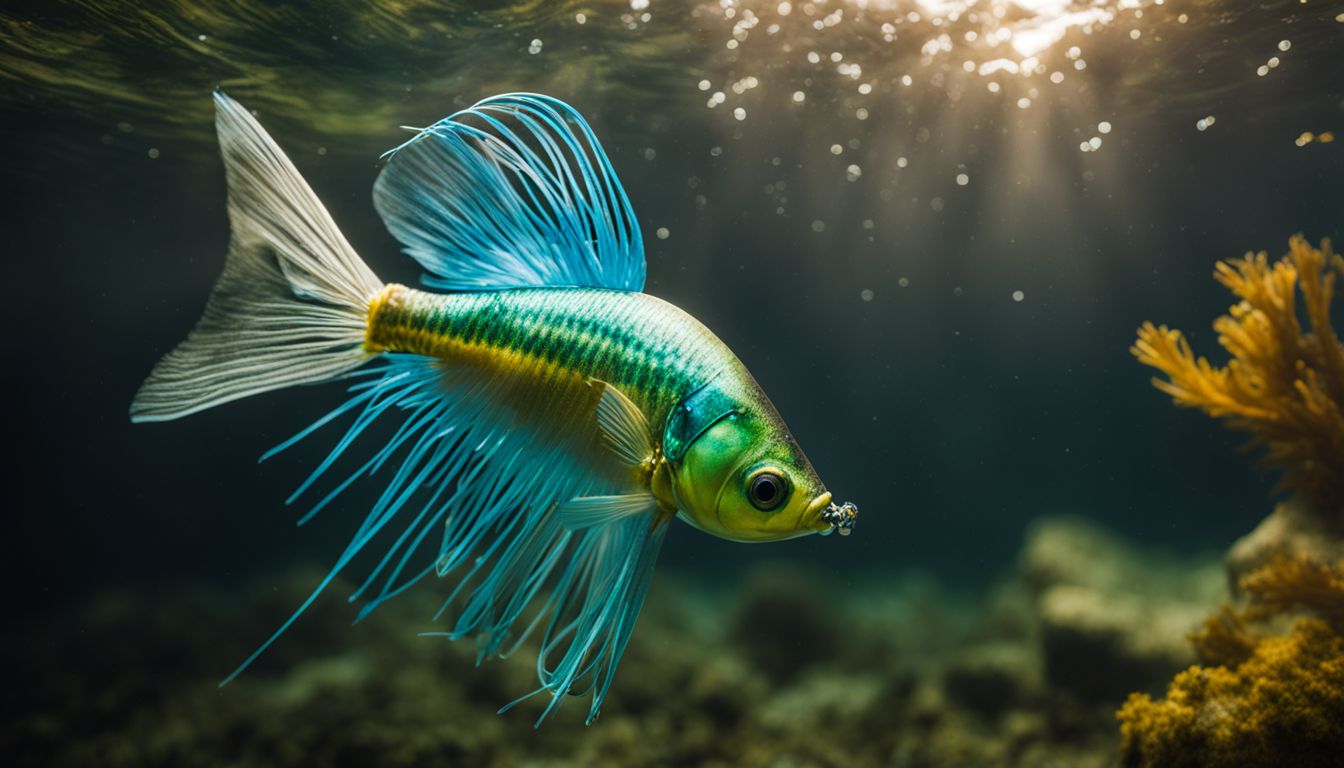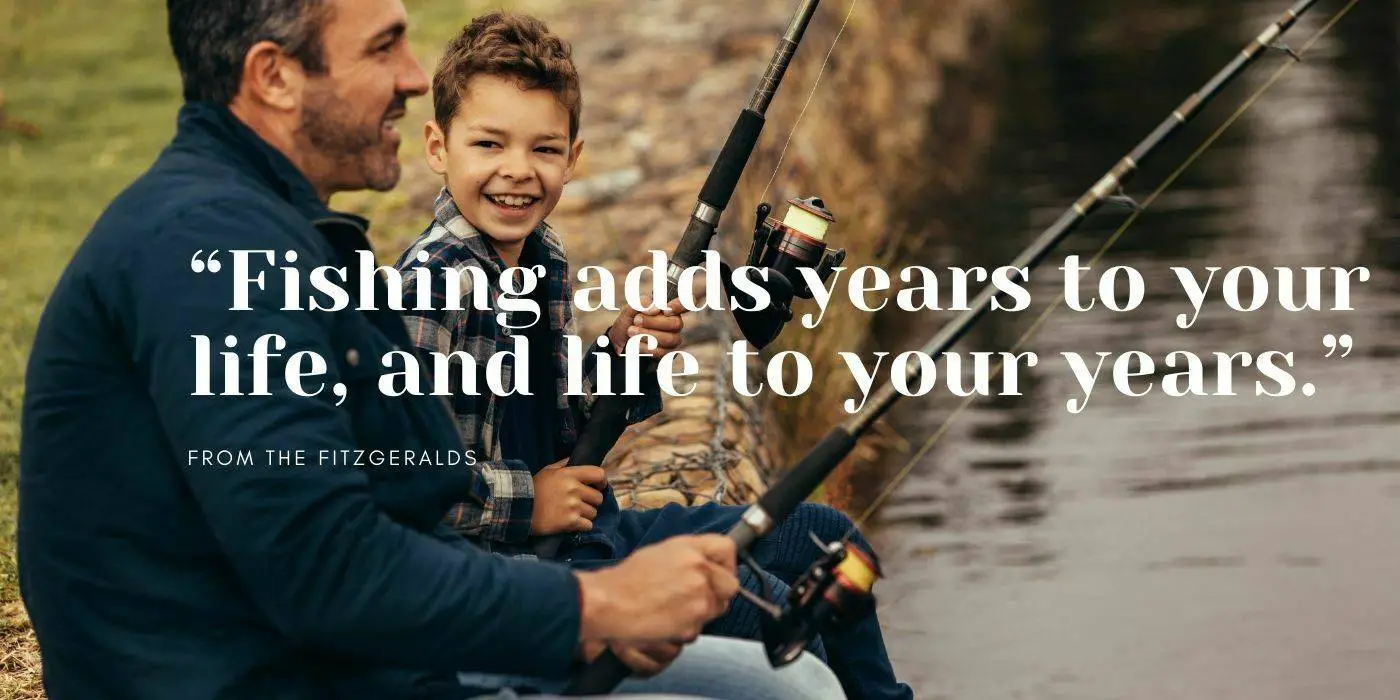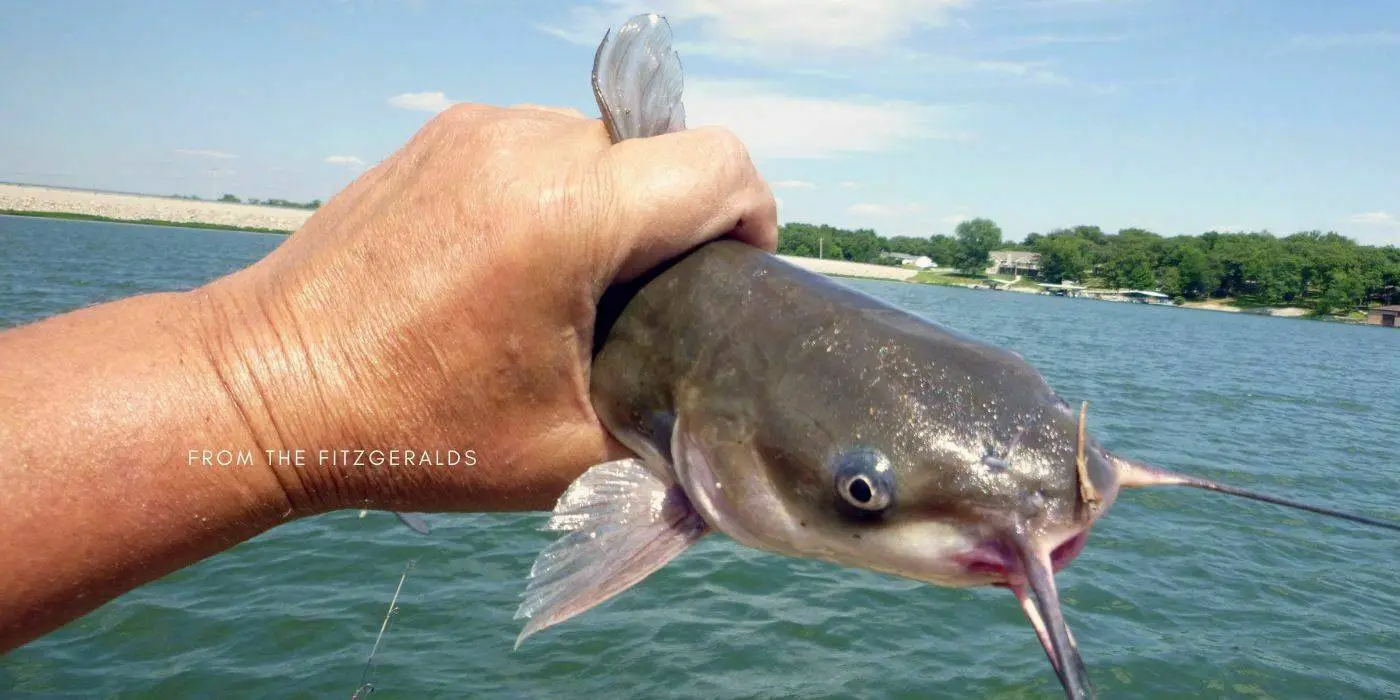Attention all fishing lovers, have you ever looked at a chatterbait and pondered how to use it effectively? Trust me, you’re not alone. Intriguingly enough, bass are quite attracted to vibrating jigs – a core feature of chatterbaits- making them an exceptional choice for lures.
This comprehensive guide is filled with expert techniques and secret insights that’ll aid in mastering the art of fishing with a Chatterbait. Are we ready to get out there and reel in that big catch? Let’s dive right in!
Key Takeaways
- Chatterbaits are a combination of a jig and spinner that create a vibrating movement to attract fish.
- Windy days and cloudy skies are ideal for chatterbait fishing because the wind creates movement in the water and clouds provide cover for the fish.
- The color of your chatterbait should match the water clarity, with darker colors working best in poor visibility and lighter colors in clearer water.
- Properly setting up your rod with the right reel, line, knot, weight, blade angle, and trailer is crucial for successful chatterbait fishing.
The Basics of Chatterbait Fishing

A chatterbait works by combining the action of a jig and a spinner, creating a unique vibrating movement that attracts fish. The history of chatterbaits dates back to the 2000s when they were first introduced to the fishing market as an innovative lure option.
Tournament anglers quickly discovered their effectiveness in catching bass and began incorporating them into their strategies.
How does a chatterbait work?
A chatterbait is a neat fishing tool. It’s like two things in one. It’s part jig and part spinnerbait. You see, it has a head with a hook at the end, covered by a skirt made of silicone.
But what makes it special is the blade or metal piece attached to it. As I pull it through water, this blade shakes fast. This rapid movement makes other fish think there’s an injured baitfish nearby! So they zoom in for what they think will be an easy meal – only to get hooked on my line instead! I can use different methods to move my chatterbait around underwater, like slow rolling or swimming moves.
History of chatterbaits
Chatterbaits have a cool past. Davis from Rock Hill, South Carolina made the first one over 20 years ago. His new kind of lure, called the ChatterBait, changed things up in the fishing world.
It had a fresh look and way of working that fish liked. This jiggling jig method was not like anything else out there. Because it worked so well, many anglers started to learn how to use chatterbaits for more fish-catching wins.
Now this fun tool is used by lots of people who love to fish and want something different to help them get their catch!
Tournament fishing with a chatterbait
Chatterbait fishing is a big hit in bass fishing tournaments. Bass love the jig’s vibrating action, making it an angler’s favorite lure. Many prize catches have been hooked with these lures! Chatterbaits are new to the scene but their results are hard to ignore.
These lures work great in almost any situation – shallow water, open water or cover spots. Even when conditions change quickly, like in tournament fishing, chatterbaits still shine.
As an angler, you just need to adjust your way and make sure you match the fish behavior.
Expert Techniques for Fishing a Chatterbait

– Mastering the chatterbait fishing technique requires understanding the best weather conditions for optimal success.
Best weather conditions for chatterbait fishing
Windy days and cloudy skies are considered ideal weather conditions for chatterbait fishing. The wind helps create movement in the water, making the chatterbait more enticing to fish.
It also helps mask any noise or disturbances caused by your presence. Cloudy skies provide better cover for the fish and make them feel more comfortable coming out to strike at your lure.
Additionally, low water visibility can work in your favor when using a chatterbait as it allows the fish to get closer without being spooked. So, on those windy and cloudy days, head out with your chatterbait and increase your chances of a successful fishing trip!
Tips for fishing in different seasons
As an angler, I know that different seasons require different techniques for successful fishing with a chatterbait. Here are some tips to help you master chatterbait fishing throughout the year:
- Spring: During the spring, bass are active and feeding after the winter. Use a chatterbait with vibrant colors like chartreuse or white to mimic baitfish. Target areas with fallen trees or rocky structures where bass like to hide.
- Summer: In the summer, bass tend to be deeper in the water to escape the heat. Fish your chatterbait near weed beds or submerged vegetation where bass seek shade and ambush prey. Try using darker-colored chatterbaits like black or brown.
- Fall: As temperatures start to cool down, bass become more aggressive in their feeding habits. Use a variety of retrieval speeds and experiment with different trailer sizes to find what triggers strikes. Chatterbaits with natural colors like green pumpkin can be effective during this season.
- Winter: Fishing can be challenging in winter due to colder water temperatures and fish being less active. Slow down your retrieve and use smaller trailers on your chatterbait. Focus on fishing near structure like docks, rocks, or brush piles where bass might still be seeking shelter.
How to fish a chatterbait for bass
I love fishing with chatterbaits for bass! Here are some tips that have worked for me:
- Choose the right rod and reel: Use a medium to medium-heavy rod with a fast action tip. Pair it with a high-speed reel for better control.
- Pick the right size and color: Start with a 3/8 or 1/2 ounce chatterbait in natural colors like white, green pumpkin, or black/blue. Adjust the color based on water clarity and conditions.
- Retrieve technique: After casting, let the chatterbait sink for a few seconds before starting your retrieve. Use a steady retrieve and vary the speed to imitate different prey movements.
- Target structure: Look for areas with cover like weeds, rocks, or submerged logs where bass might be hiding. Cast near these structures and work the chatterbait through them.
- Experiment with trailers: Adding a trailer can increase the bait’s action and appeal to bass. Try different styles like paddle tails or crawfish imitations to see what works best on any given day.
- Be patient: Sometimes bass will strike immediately, but other times they might follow the bait before biting. Keep working the area and make slight variations in your retrieve until you find what triggers their feeding response.
Understanding Chatterbait Colors and Trailers
Choosing the right colors for different situations can make all the difference in your chatterbait fishing success. Pairing them with the right trailers can further increase your chances of landing a big catch.
Read on to discover the secrets behind selecting the perfect combination and take your chatterbait fishing skills to new heights!
Choosing the right colors for different situations
When it comes to choosing the right colors for different situations when fishing with a chatterbait, there are a few things to consider. First, the water clarity plays a big role in color selection.
In poor clarity or dark, tannic, stained water, darker colors like Junebug and black tend to work best. If the water is clearer but still not ideal, a red-colored chatterbait with a golden hue can be effective.
For more typical conditions, white and chartreuse lures are popular choices, as well as black and blue lures. Lastly, green pumpkin color can also be used successfully with chatterbaits.
Importance of trailers and how to use them
When fishing with a chatterbait lure, it is important to understand the importance of trailers and how to use them. Trailers play a critical role in attracting fish and increasing your chances of catching them.
They give the chatterbait its actual profile, which is the body shape and action that bass see first. To effectively use trailers, try selecting one that closely resembles the natural forage in both size and color.
By imitating what the bass are currently targeting, you can increase your chances of success. Experimenting with different trailer options will help you find what works best in different situations.
Final Tips for Mastering Chatterbait Fishing
Properly set up your rod, target specific fish species, and personalize your approach for ultimate success on the water. Ready to take your chatterbait fishing skills to the next level? Read more to become a master angler!
Properly setting up your rod
Setting up your rod properly is crucial for successful chatterbait fishing. Here are some tips to help you achieve the optimal setup:
- Choose the right rod: Select a medium to heavy power rod with a fast action tip. This will provide the strength and sensitivity needed to handle the vibrations of a chatterbait.
- Pair it with a suitable reel: Use a high – speed reel (7:1 gear ratio or higher) to quickly retrieve the chatterbait and maintain control over your line.
- Spool it correctly: Fill your reel spool with high-quality braided or fluorocarbon line. Braided line offers excellent sensitivity, while fluorocarbon provides invisibility in clear water conditions.
- Attach the chatterbait securely: Tie your chatterbait directly to the line using a strong knot like the Palomar or improved clinch knot. Make sure it is snugly secured to prevent any slippage during casting or retrieval.
- Adjust the blade angle: Position the blade at a slight upward angle to maximize its vibration and ensure proper contact with the water’s surface.
- Fine-tune your weight selection: Experiment with different weight sizes (usually 1/4 to 3/8 ounce) depending on water depth and current conditions. Lighter weights work well in shallow water, while heavier ones are better for deep waters.
- Check your drag settings: Set your drag according to the fish you’re targeting, ensuring enough resistance to tire out bigger bass without risking a snapped line.
- Be mindful of trailer choice: Attach a suitable trailer, such as soft plastic swimbaits or crawfish imitations, which can enhance attraction and imitate prey movements effectively.
Targeting specific fish species
Targeting specific fish species is an important skill in chatterbait fishing. Chatterbaits are versatile lures that can be used to catch many different types of fish. One effective way to target specific fish species is by fishing deep grass areas with a chatterbait.
This method allows you to attract and entice certain species that prefer hiding or feeding in the vegetation. Another key aspect of targeting specific fish species with a chatterbait is matching the lure to the natural food source, also known as “matching the hatch.” By choosing a chatterbait color and trailer that closely resemble the prey that your targeted fish species typically eat, you increase your chances of success.
So when using a chatterbait, keep these tips in mind for successfully targeting specific fish species!
Personalization and experimentation for success.
To achieve success in chatterbait fishing, personalization and experimentation are crucial. It’s important to customize your approach based on the conditions and fish species you’re targeting.
Every angler has their own unique style and preferences, so don’t be afraid to try different techniques and see what works best for you. Experiment with different colors, trailers, and retrieves to find what attracts the most bites.
Remember that chatterbait fishing is all about adapting to the situation and finding what works in each specific scenario. By customizing your gear, tackle, and techniques through trial and error, you can increase your chances of reeling in a big catch while enjoying this exciting form of fishing.
Conclusion
In conclusion, mastering the techniques of fishing a Chatterbait can greatly enhance your angling skills. By understanding how this versatile lure works and utilizing expert tactics for different seasons, you’ll have a better chance at catching more fish, especially bass.
Remember to choose the right gear and tackle, avoid common mistakes, and personalize your approach for success. With practice and experimentation, you’ll become a pro at using Chatterbaits to reel in those big catches!
FAQs
1. What is a chatterbait and how does it work?
A chatterbait is a fishing lure that combines a jighead with a vibrating blade, creating noise and movement to attract fish.
2. How do I use a chatterbait effectively?
To use a chatterbait effectively, cast it out and retrieve it at various speeds, allowing the vibrating blade to create action in the water. Experiment with different depths and techniques to find what works best for you.
3. What kind of fish can I catch using a chatterbait?
Chatterbaits are known to attract bass, especially largemouth bass, but they can also be effective for catching other predator fish like pike or walleye.
4. Can I use a chatterbait in any type of water?
Yes, you can use a chatterbait in various types of water including lakes, rivers, ponds, or even saltwater environments as long as there are suitable fish species present.
5. Are there any special tips for using a chatterbait?
It’s important to vary your retrieval speed and experiment with different colors and trailers to see what the fish respond to. Additionally, targeting areas near cover such as weeds or fallen trees can increase your chances of success when using a chatterbait.




